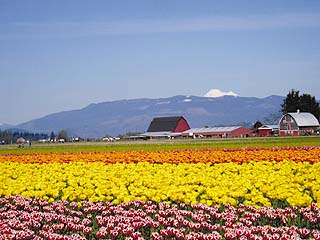
Surveys
DJC.COM
July 29, 2004
Putting a price tag on nature
Resource Dimensions

Gustanski
|

Bergmann
|
What is the value of a flowing river, not for the power it may generate or the fields it may irrigate, but for the contributions it makes daily to a myriad of wildlife, or the medley of indirect services it provides to the quality of our lives? How much would you pay for the privilege of watching eagles ride the wind as you traverse the scenic Columbia River Gorge?
Alternatively, how much should someone else have to pay for converting Olympic National Park into, say, an amusement park, or the Skagit Valley's fertile farmlands into a vast shopping complex?
Are ecological and socio-cultural aspects of a community important? Moreover, how do we know the right price to place on these resources? Will we be able to protect them for future generations? How can we strike the right balance of policy and resource management planning today — for the future?
These may be odd questions to some, but others may argue they are priceless and intangible. However, when setting environmental policies and making tough decisions about use and management of natural resources, some rational way of pricing the priceless is needed. Funding land conservation, watershed restoration, species protection, smart growth, renewable energy initiatives, and other environmental-based policy efforts is expensive.
Best value for the money

Photo courtesy of Resource Dimensions
Ecological economics helps determine the value of the natural environment, such as what the scenery of the Skagit Valley is worth. |
The following is an introduction to the basics of ecological economics and its possible application to land use and resource management planning and policy issues for the Puget Sound region, Washington state, the Pacific Northwest and beyond.
Ecosystem valuation can be a difficult and controversial task, and, as economists, we are often criticized for trying to put a "price tag" on nature. However, agencies and organizations faced with tightening budgets and growing requirements for protecting and managing natural resources must often make difficult decisions that involve trade-offs in allocating resources for the natural environment. These are economic decisions based, either explicitly or implicitly, on society's values and must be justified, not only in terms of benefits to the natural environment, but also in terms of fiscal accountability and public support.
The benefits provided by natural ecosystems are worth trillions of dollars annually in conventional economic terms; the wealth and health, not only of our region, but also of communities across all nations revolves around protecting them.
Historically, we have taken these resources for granted. Ecological economics provides a transdisciplinary framework to help us reveal the economic benefits of these goods and services to improve decisions, and set better priorities for programs, projects and policies to protect, manage and restore ecosystem integrity.
| What is ecological economics? |
|
Ecological economics is a new and evolving discipline. The tools, while not necessarily new, are used in a novel way to perform economic analyses. Most important is its commitment to transdisciplinary analysis. Traditional economic analysis is no longer adequate to help us decide how to best allocate and manage our resources. Insights from ecology, the physical sciences and sociology are required to fully observe the impact that economic activities have on the environment and our lives. Economic capital is no longer the single determinant; social and natural capital, which have been long ignored, are vital. By letting the economic, social or natural capital of a community deteriorate current community members deplete the resources available to future members. Too often, decisions have been made without consideration of the environmental costs that may be imposed on different groups within a community. Neighborhoods of low-income and minority people have commonly been used as the dumping ground for activities that harm the environment. The people living there bear a disproportionate share of the costs, while they receive little or none of the benefits. System boundary is another important concept. Economic activity does not occur in isolation; it always affects the environment and society within which it occurs. Applying appropriate analytic and physical boundaries to the social community, ecosystem and economic systems is critical to conducting an accurate assessment of policy and management options. |
Monetary value is a universally accepted measure of "economic value" because the amount that people are willing to pay for something reflects how much of all other available goods and services they are willing to give up to get it. In assessing the economic value of ecosystem services, it is important to note that measuring the value of something using dollars does not require that it be bought and sold. It only requires estimating how much people would be willing to spend to get it (or willingness to accept payment to give it up), if they were forced to make a choice.
Ecological economics uses a variety of tools developed within the fields of economics, ecology, sociology and other sciences to try to put a price on what nature contributes to our well being. Ecological economists call these ecosystem services.
Ecosystem services include climate regulation, erosion control, flood regulation, nutrient cycling, biodiversity, cultural and recreational resources, and the provision of habitat. In the West, we are all too aware that water supply, for example, is a very real service.
There are also more direct types of services, like food production, which also includes fisheries, hunting and trapping. Additionally, there are innumerable indirect services such as spiritual respite and scenic views, educational and recreational experiences, as well as contributions to real estate values and water, air and noise pollution abatement.
More than dollars
Dollars are not the only useful measure of economic value. Sometimes it is more practical to make decisions based on prioritizing the expected benefits of environmental policies. These can be used to set priorities by determining the greatest benefits per dollar spent, without resorting to dollar-based valuation. Such indicator-based valuation tools are often less expensive and require less time to apply. Therefore, they may be more broadly applicable, while still using principles of economics to assess the values of ecosystem services.
Although dollar-based measures of ecosystem benefits may be necessary to justify spending on restoration and conservation programs, non-dollar indicators of expected benefits are more useful for managing spending to achieve the greatest environmental and economic payoff.
While there remains much debate around the evolving discipline of ecological economics, its analytics transcend the traditional boundaries of economic analysis, using principles and tools from the physical and social sciences.
This approach assists us to focus on the human, ecological and economic sides of real-world resource policy and management issues. It also enables us to better assimilate regional and cultural specifics into the design of pragmatic programs to maintain key features of unique ecosystem and human economic interactions; especially those necessary to achieve sustainable futures for economic and natural systems.
The focus is on redefining growth and development from what is achievable in the short term to what can be sustained in the long term using assessments and prescriptive processes developed through interdisciplinary collaboration.
Why is this important? In the past, our market hasn't been telling us the truth about the costs of our activities. What we want to do is make the market tell the truth; and ecological economics is increasingly being relied upon to get us there. Over the past several years, more agencies and resource managers have been looking to this integrated approach as a tool to:
- Justify public spending on conservation, preservation or restoration initiatives;
- Consider the public's values, and encourage public participation and support for environmental initiatives;
- Compare the benefits of different projects, policy or program alternatives;
- Prioritize conservation or restoration projects; and
- Maximize the environmental benefits per dollar spent.
Acceptance of ecological economics has been gaining popularity since the late 1990s in the U.S., but practical application is lagging behind Europe, Australia, New Zealand, parts of Asia and Costa Rica, the first country to adopt ecological economics as official policy.
Much remains to be learned, yet we are making significant inroads, some of which has to do with understanding how people from different places and backgrounds interpret the value of the environment, and in-turn how these are valued in the market place.
Some of the first projects in the Puget Sound region taking on-board the ethos of ecological economics were launched this year in King County. A very encouraging sign!
How can we use it?
How can we use ecological economics in real-world resource policy and management decisions? Here are some examples:
• Assessment of EIS project alternatives. Conducted an integrated community-based social impact assessment for Phase I and II Lower Snake Juvenile Salmon Migration Feasibility Study & EIS for the U.S. Army Corps of Engineers to assess the social, cultural, economic and biological effects of project alternatives on communities in the region, and evaluate ways to minimize negative impacts.
• Land conservation. Developed a relational database integrated with a scenario-based model to assess economic benefits of ecosystem services generated by protected lands and their worth in the market economy. Case studies are under way in several states, including Colorado, New York, Pennsylvania and Wisconsin.
• Renewable energy. Estimated external costs and benefits related to various renewable energy technologies to provide an understanding of the market and non-market values of such projects for use as input into policy deliberations on the issue of community benefits and sustainability in Scotland.
• Estuary preservation. Conducted a socio-economic assessment of estuary use issues in Cannon Beach, Ore., and a willingness-to-pay evaluation for associated uses and preservation of the estuary.
• Water rights. Developed an integrated ecological-economics model for water rights valuation in Washington. The model melds ecological economic valuation processes with current appraisal methods to capture ecological service values in developing pricing structures for water rights.
• Agri-environmental policy and species conservation. Conducted an ecological-economic valuation to determine the economic costs and benefits of wild geese populations in Scotland and assist in developing policies for conservation and a payment scheme for crop damages incurred by farmers.
• Watershed planning. An ecological-economic assessment model was developed to demonstrate how economic, social and ecosystem values can be delineated within a watershed and how changes in ecosystem quality can be valued. Projects are under way in Minnesota and Colorado.
• Impacts of tourism. Interdisciplinary impact assessment model developed to evaluate the effects of tourism on the environment, economy and social structure of Northern Thailand’s hill tribes.
• Decision-support models. Development of various decision-support models that extend the application of traditional economics and ecological constraints to facilitate regionally based environmental decision-making and planning.
• Environmental and employment impacts. Countrywide study to determine values placed on environmental changes in landscape, wildlife, air pollution, quality of life and employment resulting from the construction of renewable energy projects in the United Kingdom.
• Community sustainability and economic development. Examined how differences between rural and urban populations influence monetary cost-benefit analysis of environmental changes, community decision-making for sustainable economies, and regional economic development.
• Consequences of land use change. Developed an integrated ecological-economic, land use and biological integrity model for a watershed in New York’s Hudson River Valley and a policy assessment model to help evaluate the sometimes-conflicting values of economic growth and environmental protection.
Ecological economics lingo
Distribution: The relative division of resources among alternative people within a community or region. How much goes to you, to me, to others, to future generations.
Economic capital: The man-made stock of resources that is useful for production of goods and services.
Ecosystem: The system of interactions between living organisms and their environment.
Ecosystem services: The beneficial outcomes that result from ecosystem functions, e.g. clean air and water, scenic views, habitat, cycle nutrients, watershed functions, carbon sequestration, and recreation.
Ecosystem valuation: The process or measurement of total economic value attributed to particular ecosystem services and/or functions derived through transdisciplinary economic analysis. Social equity and justice: Fairness in transactions between different social groups and classes. In particular, how the allocation of economic and environmental gains or losses are distributed in a community.
Natural capital: The stocks from which natural resources useful for livelihoods are derived, e.g. water, land and environmental resources.
Social capital: The degree to which a community or society collaborates and cooperates to achieve mutual benefits.
System boundary: The dividing line that determines a system that is composed of interacting parts that operate together to achieve some objective or purpose.
Transdisciplinary: Extending or going beyond the boundaries of a single discipline.
Dr. Julie Ann Gustanski, LLM, AICP, is president of Gig Harbor-based Resource Dimensions, a woman-owned firm specializing in integrated economic analyses and development of sustainable resource management and policy solutions. Ariel Bergmann, Ph.D. (ABD), MA, is a senior research economist and partner with Resource Dimensions, specializing in energy and environmental economics, with a focus on renewable energy.
Other Stories:
- Conditional closures — another cleanup remedy
- Guy Battle: design and build to suit your climate
- Washington tests watershed management
- Todd Pacific halts a dirty waterfront legacy
- Going green? Try calling on your contractor
- Emerald City must fight to stay green
- Seattle prepares to ‘re-green' 2,500 acres
- Washington's new paint law gets the lead out
- South Lake Union: a model for sustainability
- Contractor finds silver at new headquarters
- Government finds gold at Sea-Tac Airport
- Quick Duwamish cleanup begins with teamwork
- 2004: A great year for the local environment
- Getting to compliance with a systems approach
- Don't let your site be taken to the cleaners
- Salmon get a boost from technology
- Low-impact development comes to Pierce County
- Energy Star label now ready for homes
- Improving traffic flow for fish, people
- Troubling times for Hood Canal's waters
- Utilities to study energy coming into homes
Copyright ©2009 Seattle Daily Journal and DJC.COM.
Comments? Questions? Contact us.